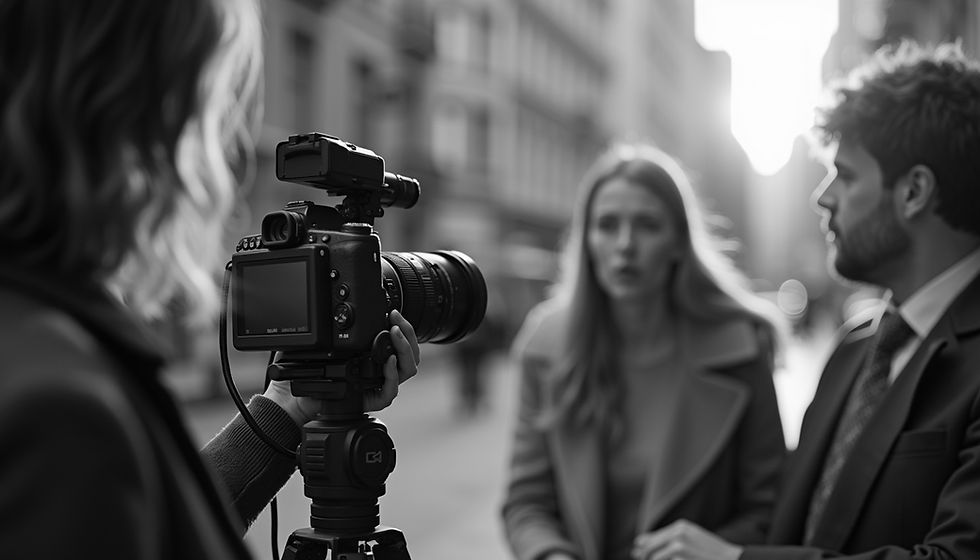Mastering the Craft of Documentary Filmmaking
- Marlon Torres

- Sep 29
- 4 min read
When I first dipped my toes into the world of documentary production, I quickly realized it’s not just about pointing a camera and hitting record. It’s an art form, a craft that demands patience, empathy, and a keen eye for storytelling. If you’re looking to create videos that resonate deeply and leave a lasting impact, mastering documentary production techniques is your gateway. Let me walk you through what I’ve learned on this journey, sharing insights that can help you elevate your projects to something truly memorable.
Why Documentary Production Techniques Matter
You might wonder, why focus so much on techniques? Isn’t the story enough? Well, the story is the heart, but the techniques are the veins and arteries that bring it to life. Without the right approach, even the most compelling narrative can fall flat.
Think of it like cooking. You can have the freshest ingredients, but if you don’t know how to blend flavors or control the heat, the dish won’t satisfy. Similarly, documentary production techniques help you control pacing, mood, and engagement. They guide your audience through the story, making sure every moment counts.
Some key techniques I always emphasize include:
Planning and research: Knowing your subject inside out.
Interview skills: Drawing out authentic, emotional responses.
Visual storytelling: Using shots and angles to complement the narrative.
Sound design: Crafting an immersive audio experience.
Editing: Weaving footage into a coherent, compelling story.
Mastering these can transform your work from amateur to professional-grade.

Diving Deep into Documentary Production Techniques
Let’s get practical. What are some documentary production techniques that can make your project stand out? Here’s what I focus on:
1. Pre-Production Planning
Before you even pick up a camera, spend time researching your topic thoroughly. I create detailed shot lists and storyboards. This helps me visualize the story arc and anticipate challenges. It’s also crucial to scout locations and understand lighting conditions.
2. Capturing Authentic Interviews
Interviews are the soul of many documentaries. I always prepare open-ended questions that encourage storytelling rather than yes/no answers. During filming, I maintain eye contact and listen actively, which helps subjects feel comfortable and open up naturally.
3. Visual Composition and Cinematography
The way you frame your shots can say as much as the words spoken. I use a mix of wide shots to set the scene and close-ups to capture emotion. Movement, like slow pans or tracking shots, adds dynamism. Lighting is another powerful tool - natural light often works best for authenticity.
4. Sound and Ambient Audio
Good audio is often overlooked but can make or break your film. I use external microphones and always record ambient sounds separately. These layers add depth and realism, immersing viewers in the environment.
5. Editing with Purpose
Editing is where your story truly takes shape. I focus on pacing, ensuring the narrative flows smoothly without dragging or rushing. Music and sound effects are added thoughtfully to enhance mood without overpowering the content.
By honing these techniques, you’ll create documentaries that not only inform but also move your audience.

What is documentary filmmaking?
If you’re new to this, you might ask, what exactly is documentary filmmaking? At its core, it’s the art of telling real stories through film. Unlike fiction, documentaries capture reality, often highlighting social issues, personal journeys, or historical events.
Documentary filmmaking is about truth and perspective. It’s not just recording facts but interpreting them through a creative lens. This means your role is both observer and storyteller. You decide what to show, how to show it, and what emotions to evoke.
This process involves:
Researching and understanding your subject deeply.
Building trust with your subjects.
Capturing footage that reflects reality authentically.
Editing to craft a narrative that informs and inspires.
It’s a delicate balance between honesty and artistry, and that’s what makes it so rewarding.

Bringing Your Vision to Life with the Right Tools
You don’t need the most expensive gear to start, but having reliable equipment makes a difference. Here’s what I recommend for anyone serious about documentary production:
Camera: A DSLR or mirrorless camera with good low-light performance.
Microphones: Lavalier mics for interviews and shotgun mics for ambient sound.
Tripod and stabilizers: To keep shots steady and professional.
Lighting kit: Portable LED lights for controlled lighting.
Editing software: Programs like Adobe Premiere Pro or Final Cut Pro.
But remember, tools are just that - tools. Your creativity and understanding of storytelling are what truly matter. I often say, the best camera is the one you know how to use well.
Elevate Your Storytelling with Emotional Impact
At the end of the day, what makes a documentary unforgettable? Emotion. When your audience feels connected, they remember your story long after the credits roll.
To achieve this, I focus on:
Humanizing subjects: Show their struggles, hopes, and dreams.
Building tension and release: Use pacing to create anticipation and relief.
Using music strategically: A well-chosen soundtrack can amplify feelings.
Incorporating visuals that resonate: Symbolic shots or recurring motifs.
These elements work together to create a powerful narrative that moves people to think, feel, and sometimes act.
If you want to dive deeper into the world of documentary filmmaking, exploring professional services can also help you bring your vision to life with expert guidance and cutting-edge technology.
Taking the Next Step in Your Documentary Journey
Mastering documentary production techniques is a continuous process. Every project teaches you something new. Don’t be afraid to experiment, make mistakes, and learn from them.
If you’re ready to create stories that captivate and inspire, start by planning carefully, listening deeply, and filming with intention. And when you’re ready, consider partnering with professionals who can elevate your work even further.
Remember, your story deserves to be told with passion and precision. So grab your camera, trust your instincts, and start crafting documentaries that leave a mark.
Happy filming!




Comments